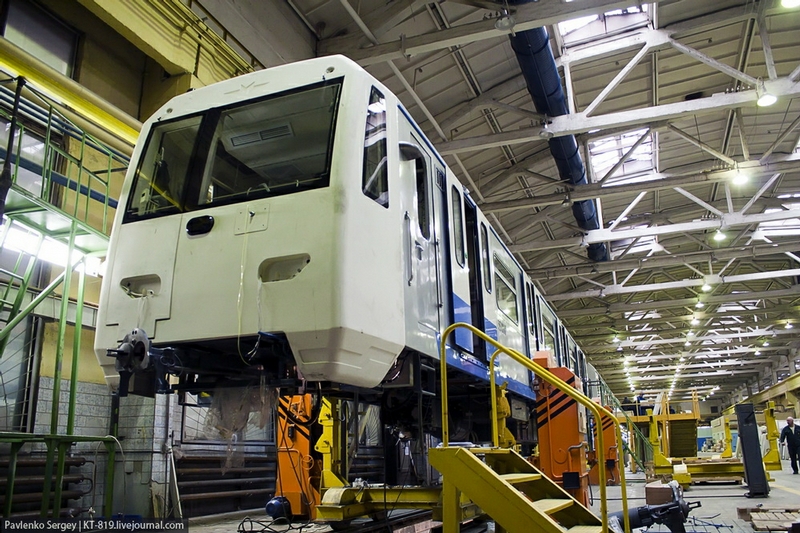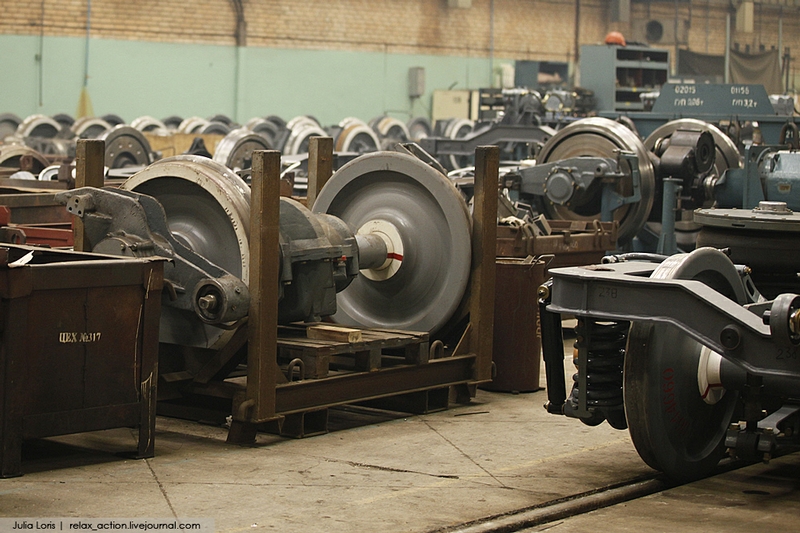- Joined
- Jul 11, 2008
- Messages
- 5,769
- Points
- 48
[h=1]
 [/h]
[/h]
Posted on February 23, 2012 by kulichik

Have you ever witnessed construction of a metro train or seen a real steam engine of the last century? The photos related to the topics are presented in the post.

Metrovagonmash is the leading manufacturer of trains for subways of large cities in the CIS and Eastern European countries. It was founded in 1897 as a carriage works and even used to produce trucks. Today almost all metro trains in Russia are manufactured here.

Metrovagonmash Joint-Stock Company.

The main metro trains produced here are numbered as 81-714.5/717.5, 81-740/741 and 81-760/761. Last year the enterprise manufactured 243 trains and repaired 113 trains. It is more preferable to repair trains at the plant because in this case new equipment is installed instead of old one at the same cost. The Moscow Subway ordered 320 trains in the current year. The volume is large enough and it was decided to order part of equipment in Tver.

It takes 70 hours to construct a train. Every train starts with a carriage.

A welding shop.

Experienced workers produce the body of the train with the help of welding.



The metal is cut, adjusted, fixed and welded. The roof, the walls and the frame are manufactured separately.

Final assembly of the carriage.



Later the carriages are placed on brakes.

The carriages packed in the white film are transported to Tver.

The carriage is painted.

The white fiberglass mask is very light.


The inside of the carriage does not look very attractive yet.

Then the train goes to the assembling shop. The very first shop where such trains were produced was numbered 17 and today all shops are assigned a number of three figures tow of which are marked as 17.

In shop 217 they are busy with mounting of equipment onto the carriage.


Trains are elevated and safely fixed which makes the procedure fast and easy.

Only a necessary amount of details is produced here. Everybody knows where every detail is stored, this helps to minimize the idle-period.





New trains are supplied with smart electronics. The inverter turns the continuous current into the alternate one and enables to control the engine and recover the energy during slowdown.



Foreign equipment acquires more popularity as high quality is in good demand.


Trains 740/741 were intended for light rapid transit and have flexible linking and modern city design. However, they showed perfect characteristics and are now exploited in tunnels as well.



As soon as assembly is finished the train is loaded onto carriages. Now it will be painted and checked.




The plant has a line which is 1 km long. It is used for mechanical run tests.

It is planned to construct a separate shop where finished products will be accepted. Rail buses are assembles at a different place. They are supplied with diesel engines and can move along any railway lines no matter if there is electrification or not.


These trains are ordered by Serbia, they differ from standard Russian trains.

Today the enterprise manufactures more complex products and can’t afford full-cycle production any more. It will increase the quality and reduce expenses on support and restoration of equipment at shops like these ones.

Posted on February 23, 2012 by kulichik

Have you ever witnessed construction of a metro train or seen a real steam engine of the last century? The photos related to the topics are presented in the post.

Metrovagonmash is the leading manufacturer of trains for subways of large cities in the CIS and Eastern European countries. It was founded in 1897 as a carriage works and even used to produce trucks. Today almost all metro trains in Russia are manufactured here.

Metrovagonmash Joint-Stock Company.

The main metro trains produced here are numbered as 81-714.5/717.5, 81-740/741 and 81-760/761. Last year the enterprise manufactured 243 trains and repaired 113 trains. It is more preferable to repair trains at the plant because in this case new equipment is installed instead of old one at the same cost. The Moscow Subway ordered 320 trains in the current year. The volume is large enough and it was decided to order part of equipment in Tver.

It takes 70 hours to construct a train. Every train starts with a carriage.

A welding shop.

Experienced workers produce the body of the train with the help of welding.



The metal is cut, adjusted, fixed and welded. The roof, the walls and the frame are manufactured separately.

Final assembly of the carriage.



Later the carriages are placed on brakes.

The carriages packed in the white film are transported to Tver.

The carriage is painted.

The white fiberglass mask is very light.


The inside of the carriage does not look very attractive yet.

Then the train goes to the assembling shop. The very first shop where such trains were produced was numbered 17 and today all shops are assigned a number of three figures tow of which are marked as 17.

In shop 217 they are busy with mounting of equipment onto the carriage.


Trains are elevated and safely fixed which makes the procedure fast and easy.

Only a necessary amount of details is produced here. Everybody knows where every detail is stored, this helps to minimize the idle-period.





New trains are supplied with smart electronics. The inverter turns the continuous current into the alternate one and enables to control the engine and recover the energy during slowdown.



Foreign equipment acquires more popularity as high quality is in good demand.


Trains 740/741 were intended for light rapid transit and have flexible linking and modern city design. However, they showed perfect characteristics and are now exploited in tunnels as well.



As soon as assembly is finished the train is loaded onto carriages. Now it will be painted and checked.




The plant has a line which is 1 km long. It is used for mechanical run tests.

It is planned to construct a separate shop where finished products will be accepted. Rail buses are assembles at a different place. They are supplied with diesel engines and can move along any railway lines no matter if there is electrification or not.


These trains are ordered by Serbia, they differ from standard Russian trains.

Today the enterprise manufactures more complex products and can’t afford full-cycle production any more. It will increase the quality and reduce expenses on support and restoration of equipment at shops like these ones.

















































































































